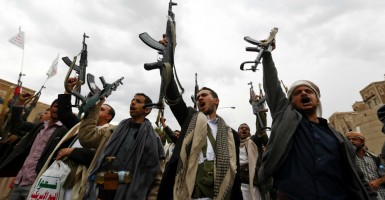Yemen has been engulfed in an intensifying civil war that has weakened U.S. counterterrorism efforts, created a vacuum of power in which al-Qaeda’s regional franchise can flourish and boosted Iranian influence in a strategic corner of the Arabian Peninsula. Yemeni President Abed Rabbo Mansour Hadi, an American ally, has fled the country.
The Houthi rebel offensive towards the southern city of Aden prompted a Saudi-led military intervention against the Iran-backed Houthis. Saudi Arabia has massed troops on the border, but is likely to stage only a limited ground operation to divert Houthi forces from advancing farther south.
The Saudi army was bloodied in previous clashes with the Houthi militia and Saudis are likely to put greater emphasis on an air campaign, which would entail less risks and potential costs.
Riyadh claims that 10 states have joined its coalition military effort, including allies from the Gulf Cooperation Council, Jordan, Egypt, Pakistan, Sudan and Morocco. Jordan has proclaimed a commitment to participate in airstrikes, but it is unclear how much effort will be mounted by the other members of this coalition.
The Pentagon has set up a joint planning cell with the Saudis to provide intelligence and logistical support for the military campaign. But the Houthis have seized Yemeni intelligence files and have compromised the U.S. intelligence network in Yemen.
Yemen now is likely to splinter into at least two states, the Shia-dominated north and the predominantly Sunni south, with several enclaves controlled by al-Qaeda in the Arabian Peninsula or tribal militias opposed to both the Houthis and President Hadi’s weakened government.
The biggest winner in the turmoil is al-Qaeda in the Arabian Peninsula, which now can fill a vacuum created by the collapse of the Yemeni state and pose as champions of Sunni Yemenis against the Shiite Houthis.
Al-Qaeda in the Arabian Peninsula, one of al-Qaeda’s most dangerous regional franchises, poses perhaps the greatest threat to the U.S. homeland by virtue of its ability to inspire terrorist attacks inside Western countries, such as the Charlie Hebdo terrorist attack in Paris in January; the shootings at Fort Hood, Texas that killed 13 Americans in 2009; the botched 2009 Christmas Day attack by the “underwear bomber” who sought to explode an airliner over Detroit; and the failed attempt to detonate a car bomb in New York’s Times Square in May 2010.
The group also boasts a master bomb maker, Ibrahim al-Asiri, who has designed and deployed sophisticated bombs that are difficult to detect by airport screening devices.
The disintegration of Yemen exposes the weakness of the Yemeni counter terrorism model, which was lauded by the Obama administration only months ago as a success that could be replicated in the fight against the Islamic State in Syria and Iraq.
Iran’s involvement in arming and funding the Houthis also raises disturbing questions about the Obama administration’s kid glove treatment of Iran, as it turns a blind eye to Iranian troublemaking in a desperate effort to secure a nuclear deal.




























